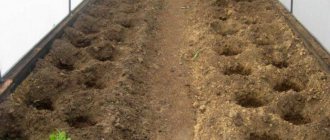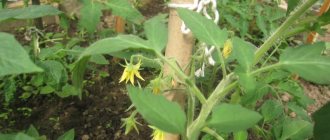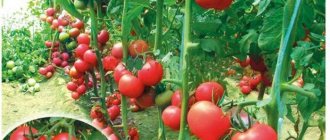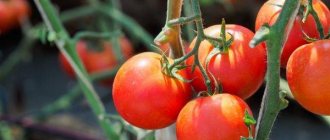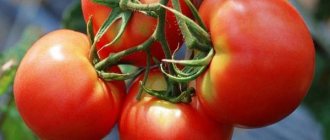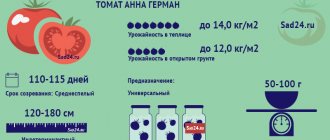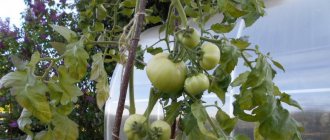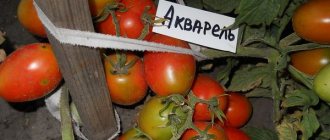Rules for growing Bella Rosa tomatoes: planting seedlings and transplanting to a permanent place
Typically, this variety is grown by seedlings - in this case, it is possible to obtain harvests several weeks earlier than the period indicated in the description.
Sowing Bella Rosa tomato seeds for seedlings is carried out in March - a couple of months before transplanting the seedlings to a permanent place. Specific planting dates are calculated depending on weather conditions in the growing regions.
It is important to know!
Since the variety does not tolerate low temperatures and is not intended for cultivation in greenhouse conditions, Bella dew is not recommended for planting in regions with harsh climates.
Seed preparation
Seeds of this variety cannot be collected from bushes in the garden - the plants grown from them will not retain positive parental characteristics. Therefore, seed material must be purchased annually from specialized stores.
How to germinate tomato seeds
Such seeds undergo pre-sowing treatment in companies that sell them. Therefore, at home, they only soak tomato seed material in damp gauze for germination. Growth stimulants can be added to the water.
Preparation of nutrient substrate
Nutrient substrate for growing tomato seedlings is usually purchased in specialized stores. But you can cook it at home. To do this, in the fall, gardeners stock up on garden soil, humus or compost, coarse river sand and peat. In the spring, all these components are mixed, wood ash and sphagnum moss are added to make the soil loose.
INTERESTING! Iodine for tomatoes against late blight
Home-prepared soil mixture for seedlings should be disinfected before use. To do this, it is calcined in an oven heated to 180 degrees for 30 minutes.
Sowing tomato seeds for seedlings
The prepared substrate is laid out in containers, grooves no more than 1 cm deep are made in it. The distance between the grooves is about 2.5 cm. The seed material is laid out in the grooves at a distance of a couple of centimeters from each other. Then the ground is leveled and watered with a spray bottle.
The top of the container with Bella Rosa tomato seedlings is covered with polyethylene and transferred to a dark, warm room until the sprouts appear.
Typically, seed material begins to actively germinate 5-6 days after sowing.
Further care of Bella Rosa seedlings
After the shoots emerge, the polyethylene must be removed and the containers moved to a well-lit place. In the future, caring for Bella Rosa seedlings consists of regular watering and fertilizing.
Video about tomato seedlings
Tomatoes are watered as the soil dries with warm filtered water. If the water is cold, then such watering can provoke the development of blackleg or root rot in seedlings.
After the seedlings have a pair of permanent leaves, they should be picked into separate containers. 10-12 days after picking, the first fertilizing of Bella Rosa tomatoes is applied to the soil.
Usually urea or other fertilizers containing nitrogen are used for this.
. 12-14 days before transplanting plants to a permanent place, a second feeding should be done. Its composition does not differ from the first feeding.
On a note!
10-12 days before planting the seedlings in the beds, they are hardened off. To do this, the tomato plants are taken out onto the balcony or loggia for a short time at first, but gradually the time the plants stay outside increases.
Transplantation to a permanent place
The area for planting tomatoes is prepared in advance. Compost is added to the depleted soil before digging in the autumn - 7-8 kg for each square of area. In spring, 20 g of potassium salt and superphosphate are added to the planting holes.
When replanting, you need to remember that no more than 4 Bella Rosa tomato bushes should grow on each square of area.
Bella Rosa tomato seedlings are transplanted into open ground in mid-May, when it warms up well.
. The plants are transferred to the planting holes together with a lump of earth; if necessary, soil is added to the holes, compacted and watered. Then the root zone of the plants should be mulched.
Possible difficulties during cultivation
Usually in a greenhouse this tomato grows very much, it needs to be constantly tied up and supported. In this case, we can advise you not to delay tying or pruning the bush, because it is much more difficult to work with a very overgrown plant.
If the soil is over-moistened, tomatoes may begin to crack. Start watering them less often and less; 3-4 liters of water will be enough for each bush.
Diseases and pests
Danko is resistant to fungal and viral diseases of nightshades. However, these diseases can be transmitted through infected tomatoes from neighboring beds. For this reason, tomatoes should not be planted next to other nightshades. Other causes of disease can be excessive watering of plants, poor ventilation and excessive growth of the bush.
Of the pests, Danko is most susceptible to attack by spider mites, whiteflies and mole crickets. Such products as Fitoverm and Karbofos are actively fighting them.
Prevention and protection
Immediately after transplanting, the tomatoes are sprayed with copper sulfate, and the soil in the garden bed is dusted with ash. When watering, ordinary water is alternated with manganese or ash solution. If tomatoes grow in a greenhouse, carry out regular ventilation. To avoid blossom end rot, bushes are sprayed with calcium nitrate.
Tatyana Orlova (Vasilidchenko) (candidate of agricultural sciences):
Blossom rot is a physiological disease caused by a lack of calcium in plants. This deficiency occurs either on acidic soils, so they are limed. But at high soil temperatures (above +30 degrees), even if there is a sufficient amount of calcium in the soil, the tomato roots stop absorbing it. To do this, carry out quick foliar feeding of the leaves with calcium nitrate.
If prevention does not help, it is necessary to use special preparations - fungicides, while observing safety precautions.
Popular due to its taste and ease of care - Danko tomato: description of tomatoes and characteristics
Tomato Danko is one of the most popular varieties for planting among many gardeners and gardeners. It is famous for its excellent taste, unpretentiousness, and large-sized tomatoes.
| Height | Landing location | Ripening time | Fruit color | Fruit size | Origin | Fruit shape |
| short | Greenhouse, Open ground | Mid-early | Reds | Large | Variety | Heart-shaped |
Description and characteristics of the variety
Tomato Danko "Siberian Garden" is suitable for growing in the northern regions, in the temperate zone under cover. Bushes are planted in open areas in southern areas.
The ripening period is mid-early - 102-115 days from germination.
- average weight 150-300 g, large specimens reach 500 g;
- the shape resembles a heart;
- color bright red;
- intended for salad, also used for sauces, ketchups;
- the taste is sweetish with sourness;
- the flesh is fleshy and sugary.
- compactness of bushes;
- simple agricultural technology;
- excellent taste;
- fast ripening.
Minuses:
Features of cultivation and storage
At the age of 55-60 days, the bushes are transplanted to stationary beds. The optimal placement scheme is 4 plants per 1 m2.
- formation is carried out in 3-4 stems;
- tied to pegs;
- water moderately 2 times a week;
- loosen and remove weeds;
- mulch with a layer of 7-8 cm.
Planting and care
The soil substrate can be purchased at an agricultural store or made independently. To do this, mix:
The soil is disinfected with 1% potassium permanganate or by calcination in the oven.
The boxes are kept warm under film until germination. In order for the seedlings to grow strong, they are cared for:
- irrigation with warm water;
- hardening at a temperature of 14 degrees for 1 week;
- feeding with Kemira-universal once every 10 days;
- diving with 2-3 true leaves in a 0.5 liter container.
Features of growth and development
Characterizing a variety as determinate means that the height of the bush is not too high. In open ground conditions, the plant grows only half a meter, sometimes a little higher - 70 - 80 centimeters.
After this, the bush stops growing on its own, forming a flower cluster at the top instead of a growth point. This makes the vegetable grower’s work easier: there is no need to top up in August.
In greenhouses, the Danko tomato behaves as a semi-determinate plant. The bush is capable of growing to a height of 150 – 180 cm. Such dimensions are achieved using a special technique. When the main stem forms a flower cluster instead of a growth point (tops), it is replaced by an upper stepson, which continues to grow upward.
Heart-shaped fruits
The Danko tomato is not a hybrid. You can easily get your own seeds by saving typical tomatoes from the most generous bushes.
Bright color
When fully ripe, the fruits acquire a rich blood-red color. Unripe tomatoes of the Danko variety have a dark green spot near the stalk, which completely disappears when ripe.
In the conditions of the Middle Zone, in Siberia, in the Urals, in the open air, from a third to half of the crop turns red on the vine. The rest of the tomatoes ripen well in storage. Greenhouse conditions allow you to remove all the fruits that are red or brown.
Salad pulp
The most important quality of Danko tomatoes is the excellent taste of the fleshy fruit. Under the thin skin lies a sugary pulp with a small amount of seeds. The consistency is moderately juicy, but not liquid. Tasting score: 10 points out of 10 possible.
Significant return
https://www.youtube.com/watch?v=pwxBh2nZiOs
The minimum yield of the variety is 4 kg per square meter. This number is only valid for open ground in the northern regions. The potential is much higher: it all depends on the growing conditions. You can remove 4–5 kg from a bush, and this is not the limit either. Greenhouse conditions and competent agricultural technology make it possible to obtain 6–7 kg of fruit from one plant.
The Danko variety of tomato has one amazing property - a clear contrast between the crop load and the size of the plant. The bushes look delicate, even frail, the foliage is rather weak, and against this background there is a record weight of fruits.
The review variety is a salad tomato that is very good fresh. In cooking, the fruits serve as ingredients to be added to various dishes. Due to their tendency to crack, Danko tomatoes are not particularly suitable for canning. Tomatoes make delicious juices, tomato paste, sauces and ketchups.
Subtleties of agricultural technology
The Danko tomato is one of those varieties that any gardener will like. A lazy or too busy summer resident will get vegetables with a minimum of effort. An experienced and diligent vegetable grower will reveal the potential inherent in the variety and will be satisfied with the maximum output.
- Young seedlings grow frail and tend to stretch. During the seedling period, they need increased care and attention: moderate heat, good lighting, dosed feeding.
- The optimal age of seedlings when transferred to a greenhouse or soil is 55 days (plus or minus a week). Planting overgrown or undergrown seedlings leads to a significant crop shortage.
- You can place bushes in open ground quite densely, 6–8 pieces per square meter. Plants are not prone to thickening and have little foliage. In a greenhouse it is enough to plant 4 pieces per square meter.
- Pinching is the most important operation when growing Danko tomatoes. Side shoots grow very quickly and actively, so plants have to be pruned often. The bushes grow strictly into one or two stems. Thickening leads to a serious shortage of yield and underweight of fruits.
- Another important technique when working specifically with the Danko variety is normalization of the ovaries. The tassels sometimes grow excessively long, and some flowers are ugly or weak. It is recommended to leave four neat flowers in each brush, mercilessly plucking out the double and small ones. The work will not take much time, but will improve the quality of the fruit.
- The keeping quality of tomatoes is not too high. Delicious fruits need to be put to use quickly - for fresh salads and winter preparations.
Danko tomatoes are not very suitable for whole-fruit pickling - they are too large, but for pickling in barrels according to old recipes they are ideal. They also make the most delicious ketchups and juices.
Characteristics and description of the Canopus tomato variety, yield
The name of the famous variety is consonant with the name of the star of the southern hemisphere, a bright giant that illuminates the night sky with a fabulous brilliance. Like its “cosmic namesake,” the Canopus tomato is a guiding star in the “garden universe” of experienced summer residents. Even novice gardeners can cope with growing this unpretentious tomato variety!
People who have already been lucky enough to plant hybrid tomato seeds note not only its excellent taste characteristics, but also its ease of care. Canopus tomatoes need minimal amounts of mineral fertilizers, regular watering with warm water and sunlight.
How to plant tomatoes correctly
It is recommended to grow Danko variety tomatoes using the seedling method. The timing of sowing depends on the method of growing the crop and the weather conditions of the region. For greenhouse complexes, sowing work is carried out 3-4 weeks earlier than for cultivation in open ground.
- Planting material is purchased in specialized stores or collected independently.
- The seeds are sorted, getting rid of damaged and non-viable specimens. To select seed material for planting, a warm saline solution is poured into a container, into which the seeds are placed and left for 20-30 minutes. The floating seeds are discarded, the rest are dried for further preparation.
- Next, the seed material is treated in a solution of manganese and a growth stimulator.
- The day before sowing, the seeds are placed in a damp cloth and sent to the bottom drawer of the refrigerator for hardening.
- Fertile soil mixture can be purchased in stores or made independently by mixing garden soil with mineral and organic substances.
- On the day of planting, soil is poured into containers prepared for seedlings, holes or grooves are dug on top, no more than 2 centimeters deep.
- Prepared seeds are placed in each hole, sprinkled with soil on top and irrigated with a sprayer.
- Containers with plantings are covered with plastic film and moved to a warm place.
- After the shoots appear, the film is removed, and the containers with the plants are sent to a well-lit, warm room.
- After 3-4 tomato leaves appear, the bushes are planted in different pots, containers or glasses.
Seedlings are transferred to a permanent place of growth at the age of 1.5-2 months.
In greenhouses and greenhouses
Preparing the soil for growing tomatoes in a greenhouse begins in the fall.
- The top layer of soil is carefully dug up, loosened, mixed with organic matter and minerals.
- With the onset of spring, planting holes are dug in the beds, 25-30 centimeters deep.
- The distance between plantings is 50-60 centimeters, between ridges up to 80 centimeters.
- Seedlings are placed in the prepared holes, the bushes are sprinkled with earth on top and moistened.
Expert opinion
Stanislav Pavlovich
Gardener with 17 years of experience and our expert
Ask a Question
Important! In greenhouse conditions, this tomato variety is prone to overgrowth, so the bushes will need additional support
In open ground
When transferring seedlings to open ground, level, well-lit and dry areas of land are chosen for the beds.
The remaining activities are carried out in the same way as with the greenhouse growing method.
Transplantation of seedlings into open ground is carried out 2-3 weeks later than in greenhouses.
Description of the variety
Those who have at least once planted Danko on their plot will certainly return to this tomato again. The tomato is not high-yielding, but it bears fruit consistently, regardless of climatic and other external factors.
Attention! It is simply impossible not to notice and remember the Danko tomato. Beautiful, heart-shaped, raspberry-colored tomatoes that stand out among their red, yellow, and even black counterparts
The Danko tomato variety was developed by domestic breeders, and it belongs to the Siberian selection of tomatoes. This means that the tomato tolerates low temperatures and lack of sunlight very well, that it is not picky about the composition of the soil and is ready for any weather changes.
Characteristics of the Danko variety:
- the tomato is of a determinate type, that is, the bushes have a final growth point;
- the height of the bushes is small - about 50 cm, they are compact, not too thick;
- a universal-purpose variety: suitable for growing in the ground and in a greenhouse (in greenhouses, a tomato can grow up to 120 cm);
- fruit ripening dates are mid-early - 110 days after germination, tomatoes will begin to turn pink;
- It is recommended to form Danko bushes with 3-4 stems - this will significantly increase tomato yield;
- There is no need to plant a tomato; when grown in a greenhouse, the bushes may need support;
- the Danko variety tolerates not only cold, but also severe drought and summer heat;
- the largest tomatoes are formed in the lower clusters;
- the shape of the fruit is heart-shaped, the surface with barely noticeable ribbing;
- The color of unripe tomatoes is light green; when the tomatoes ripen, they turn red-orange and have a dark green spot near the stalk;
- the average fruit weight depends on the growing method: in the ground - 250 grams, in greenhouses - about 400 grams;
- The Danko tomato has an excellent taste, the flesh is sugary, dense, very sweet;
- the peel on the fruit is thin, so Danko is not suitable for long-term storage and transportation;
- The purpose of tomatoes is salad - they are best eaten fresh;
- the yield of Danko tomatoes is average - about 3-3.5 kg from each bush;
- Danko tomatoes have a good presentation, but due to their thin skin they often crack;
- the variety has good resistance to “tomato” diseases and is rarely affected by pests;
- Thanks to the early ripening juices, the tomato is rarely susceptible to late blight, which peaks in August.
Important! The yield of large-fruited pink tomato can be easily increased if you plant no more than four bushes per square meter of soil. This planting scheme will allow you to collect up to 10 kg from a bush.
Advantages and disadvantages
Reviews about Danko tomato are mostly positive. The most important quality of this variety is its versatility: Danko can be grown in open ground in any region of Russia (from the south to the Urals), this tomato is also suitable for planting in a greenhouse; it does not require a lot of light and heat for normal development.
Danko tomatoes have several more important advantages, such as:
- excellent taste;
- beautiful appearance of the fruit (as proven by the photos from the article);
- large size tomatoes;
- compact bushes;
- good yield;
- immunity to various diseases and resistance to pests;
- the ability to bear fruit in difficult climatic conditions (be it intense heat, high humidity, drought or uncharacteristically low temperatures for summer).
Important! Another advantage of Danko tomatoes is the ability of the fruit to ripen at room temperature. This quality allows you to save the harvest in the northern regions, where summer ends very quickly
It is clear that the description of the Danko variety will not be without its shortcomings. After all, like all pink tomatoes, this tomato does not tolerate transportation well, it is unsuitable for growing on an industrial scale, and can crack from excess soil moisture.
Although the Danko variety is capable of bearing fruit in poor conditions, the tomato yield will sharply decrease – the fruits will begin to form in limited quantities. Adding to the complexity of agricultural technology is the fact that tomatoes grow stronger in greenhouses, so their bushes will have to be tied up or support must be found for them.
Advice! You should not plant tomatoes like Danko in large quantities, because their fruits are intended for fresh consumption, and they cannot be stored for a long time. For a small family, a few bushes of this variety will be enough.
Varietal features
The tomato variety Danko is determinate or semi-determinant. In open ground it reaches 60-70 cm, and in a greenhouse it grows to 150-180 cm. Ripening period is mid-early or mid-season. The harvest is harvested 110-115 days after emergence.
External description of the fruit
The shape and color of Danko tomatoes resemble a bright red heart. The name of the variety is connected with this: according to legend, a young man named Danko saved his people - he led them out of the dark forest, lighting the way with a fiery heart.
The weight of tomatoes ranges from 150 to 300 g, but there are also larger specimens (according to gardeners’ descriptions, up to 600 g). The fruits are distinguished by a rich sweet taste and juicy, moderately fleshy and sugary pulp. The skin on them is thin, prone to cracking.
Tomatoes are great for cutting and making salads. They are a delicious snack to eat just like that, between main meals.
Juicy fruits are often used for sauces, pastes, ketchups, and juices. They are not suitable for canning.
Productivity
For a determinate variety, the yield is very high. 3-4 kg of tomatoes are harvested from each low-growing bush. When grown in a greenhouse, tall bushes are obtained, each of which produces 5-6 kg of fruit.
Disease resistance
There is no reliable data on increased immunity, however, according to reviews from gardeners, Danko tomatoes get sick no more often, if not less often, than other varieties.
To avoid fungal diseases, prevention and crop rotation are necessary.
Due to the sweet large fruits, the tomato is a tasty bait for insect pests (which is why regular inspection of the bushes for damage is so important).
Tatyana Orlova (Vasilidchenko) (candidate of agricultural sciences):
Insect pests do not feed on fruits, but on green parts of plants. Therefore, the degree of damage to fruits of a particular variety does not depend on their taste. True, bollworm caterpillars also damage green fruits, regardless of their taste.
Characteristics of Danko variety tomatoes
When choosing a tomato variety for planting, first of all, pay attention to the taste of their fruits. One of the most advantageous in this regard is the Danko tomato. It has an exquisite taste and original shaped fruits.
They look like a bright burning heart
It has an exquisite taste and original shaped fruits. They look like a bright burning heart.
Characteristics of Danko variety tomatoes
Plant characteristics
- The Danko variety belongs to the determinate tomato species.
- These tomatoes are grown both in open ground and in greenhouses.
- The tomato belongs to the mid-early varieties.
- The height of the bush is about 55 cm.
- The fruits can be either medium or large.
- More than 3.5 kg of products are collected from one bush.
- The tomato is characterized by increased drought resistance.
- Danko is not exposed to viruses and diseases, but requires preventive measures.
When growing in open ground, it is permissible to leave several stepsons, then the bush will be more lush, which will increase its productivity.
Fruit characteristics
According to the description, the flowers of the Danko tomato variety are pollinated alternately. Early harvesting gives the plant the opportunity to make efforts to form new inflorescences, which significantly increases the yield of each bush.
Heart-shaped fruits. Ripe Danko tomatoes are pink or red in color and have a sweet taste. The aroma is pronounced and has a honey note.
Description of the bush
In greenhouse conditions, the bush needs to be pinched, leaving 4 main stems, and tied up. The stems are gnarled and weakly branched. Brushes are formed in the area of the 7th leaf, the next ones appear after 2-3. The inflorescence is complex, each stalk has an articulation. About 6 brushes are formed, each containing up to 10 flowers.
The plant needs pinching
No more than 120 days pass from germination to harvesting the first harvest.
Disadvantages of the variety
This feature makes the Danko tomato variety non-transportable, so industrial tomato cultivation is unprofitable.
Growing seedlings
To successfully grow seedlings, you must follow the rules of agricultural technology. It is necessary to provide:
- a certain soil composition;
- correct sowing of seeds;
- temperature regime;
- timely watering.
Before planting seedlings in the ground, at least 65 days must pass from sowing the seeds.
The soil should contain the following components: 60% garden soil, 15% peat, up to 15% humus and 10% wood ash. Drainage is poured into deep bowls, and a layer of prepared soil is placed on top. The seeds are soaked overnight in a weak solution of potassium permanganate, then washed thoroughly and placed in the ground. Sprinkle the top with a layer of earth no more than 1 cm.
The surface of the soil is sprayed and covered with a transparent film. The seedlings are placed in a bright place and maintained at a constant temperature. Fluctuations are possible between 15°C and 25°C. Warm water is periodically sprayed from a spray bottle. Sprouts should appear after 6 days. After two pairs of leaves have formed, they are picked and covered again. As the seedlings grow, the cover is removed.
Drop-off
It is important to form the bush correctly
Before planting in open ground, the sprouts are hardened. It is carried out 2 weeks before the disembarkation date. On the first day, bowls or pots with seedlings are exposed to the open sun for no more than 10 minutes.
In open ground, markings are done so that for 1 sq. m accounted for 3 plants. In a greenhouse, it is possible to plant 4 plants in the same area. The holes are made wide and deep, a handful of wood ash is thrown into them and watered with warm water.
The main care measure is timely, abundant watering.
It is necessary to remove weeds and loosen the top layer of soil, eliminating crusts formed after watering.
Tomatoes are fertilized after they take root in a new place. Foliar feeding is carried out with mineral fertilizers and microelements, alternating with organic matter.
Advantages and disadvantages
- The Danko variety is a determinate species; when grown, a fairly compact bush is obtained.
- Ripe tomatoes are very tasty.
- Inside the fruits there is dense and juicy pulp.
- Green tomatoes can ripen quickly indoors.
- Do not require frequent watering.
- The fruits have an attractive appearance.
- The variety is drought-resistant.
- It has complex resistance to viral and bacterial diseases of tomatoes.
Flaws:
- It is also worth noting that delicate fruits are difficult to transport even over long distances.
- Many gardeners are not attracted to the mandatory process of tying up bushes.
Further care
Another very important stage in growing Danko tomatoes is further care of the bushes. It includes timely watering and fertilization, constant care of the land, treatment against diseases and pests.
Watering
This procedure must be carried out regularly, but you do not need to water the tomatoes for the first 8–10 days so that they take root better. Then you need to water every 7-8 days, 1 liter of heated water for each plant. It is better to use the drip method at the root of the bush, since water getting on the leaves can lead to the development of fungal diseases. When the fruits begin to ripen, the amount of water should be increased to 2 liters per plant after 5-6 days. It is better to water in the afternoon, when there is no sun.
Important! It is necessary to constantly ensure that there is no stagnation of water in the ground, as this can cause the tomatoes to get sick.
Fertilizer application
Fertilizing is very important for obtaining a high yield of Danko tomatoes.
It is done several times per season, namely:
- The first feeding is carried out 7–10 days after planting: for this use 0.5 liters of liquid mullein, 1 tbsp. a spoonful of nitrophoska and 10 liters of water with the calculation of 0.5 liters of fertilizer per bush.
- The second feeding is carried out when the second flower cluster begins to bloom: in 10 liters of water you need to dilute 0.5 liters of chicken droppings, 1 teaspoon of potassium sulfate, 1 tbsp. a spoonful of superphosphate, 1 liter of solution per bush.
- The third feeding is done 2 weeks after the second: 1 tbsp. spoon of nitrophoska, 1 tbsp. Dilute a spoonful of “Ideal” fertilizer in 10 liters of water, water 1 liter of solution per plant.
- The fourth feeding occurs during the period when the fruits appear: 1 tbsp. Dilute a spoonful of superphosphate in 10 liters of water at a rate of 2–2.5 liters per bush.
Soil care
After each watering, it is necessary to loosen the soil around the plants, while removing grown weeds, in order to avoid the occurrence of various fungal diseases. The first loosening must be made deeper to provide the tomato roots with warm air. Subsequent loosening should not be as deep. You can hill up the bushes 2-3 times per season, due to which the root system develops better and plant nutrition improves.
Garter bushes
To provide tomato bushes with reliable support, they must be tied to pegs. Taking into account the height of the Danko tomato bushes, the pegs are prepared 120–130 cm long. They are placed at a distance of 10 cm from the plant and deepened 20–30 cm into the ground. Plants are tied to the support freely; the garter material should not be thin so as not to damage the trunks. As the tomatoes grow, the bushes are tied several times.
Read more about the step-by-step guide to garter tomatoes.
Preventative treatment
Preventive measures are carried out from the moment the seedlings are planted in open ground until the fruit begins to ripen. In order to protect the bushes from infection with fungal diseases, it is better to plant them far from potatoes, eggplants, peppers and other nightshades, and also treat them with special preparations:
- a week after planting the seedlings in a permanent place - use the drug "Aktara" (4 g per 10 liters of water);
- before the start of flowering - Abiga Peak solution (5 g per 10 l of water);
- after flowering - with the drug "Oxychom" (30 g per 10 liters of water);
- when the first fruits begin to appear - with the preparations “Ridomil” (25 g per 10 liters of water) or “Abiga Peak”;
- 3 weeks before harvest - with Abiga Peak or Ridomil.
Diseases and pests
Review variety tomatoes have good resistance to diseases such as:
- Late blight;
- Gray rot;
- Tobacco mosaic.
Tomatoes can become infected with fungi and bacteria from plants that grow in close proximity. For preventive purposes, the Danko variety is planted far from agricultural crops of the nightshade family. Treatment with special chemicals, as well as the use of folk recipes, will not harm the bushes.
The best determinate varieties of tomatoes for open ground
Determinate varieties of tomatoes are convenient to grow in open ground. They do not need such high support as tall varieties need, and if they need formation, it is minimal. Experienced agronomists advise new farmers and gardeners to start growing tomatoes with indeterminate varieties. In addition, low-growing tomatoes usually ripen quickly and smoothly, and therefore they are perfect for regions with short summers.
If you are looking for a suitable variety of low-growing tomatoes, then you can definitely choose something from the options offered below. We have selected for you the best determinate varieties of tomatoes for open ground.
The best low-growing tomato varieties for exhaust gas
Rio Grande
A variety of Dutch selection, the bushes of which can reach 50-60 centimeters in height in open ground, and the inner part of the medium-sized plum-shaped fruits has good elasticity. Thanks to this, they are perfectly stored and are suitable for pickling and drying.
Determinate tomato Rio Grande
Bobcat
This variety was developed by the Dutch, endowing it with excellent commercial qualities. Large and beautiful fruits have a high dry matter content, which makes them suitable for long-term transportation. Bobcat tomatoes are suitable for growing in open ground exclusively in the southern regions. They have good immunity and long-term fruiting.
Tomato Bobcat
Linda
One of the new determinate varieties of tomatoes. The fruits are quite large and dense - ideal for salads and store well. A strong plant is rarely infected with various diseases and, with proper care, always produces an excellent harvest.
Tomato variety Linda
Mystery
The main trunk reaches a height of 45 cm and is quite strong so that the tomato does not fall without a garter. However, regular stepsoning is necessary. Riddle is an ultra-early variety. The fruits reach a weight of 150 g, beautiful and dense.
Beautiful Danko tomato fruits
Petrusha the gardener
This variety is one of the last fruits of the labor of Siberian breeders. By growing it, you don’t have to waste time and energy on planting. Its fruiting period is long, its yield and drought resistance are quite high, and its fruits are universally used. The 60-centimeter bush looks very elegant in an area of open ground.
Parsley gardener - an elegant tomato bush for open ground
Danko
A tomato with large heart-shaped fruits covered with a thin peel. Height - 50 cm, the bush needs to be formed and strengthened. It has good drought tolerance and excellent taste. Productivity is average, transportation is not advisable.
Heart-shaped tomato variety Danko
Crimson Giant
This hybrid has truly gigantic raspberry fruits. The average height of the bushes is 70 cm. The fruits ripen early, so late blight cannot overcome them. The greatest advantage is the highest productivity.
Huge fruit of the Raspberry giant variety
Roma
Determinate variety of tomatoes of medium ripeness with plum-shaped fruits of high quality. The plant is standard - a garter may not be required. This hybrid is usually grown for canning.
Roma - tomato for canning
Summer resident
Gardeners love the tomato for its unpretentiousness, endurance of low temperatures, and consistently high yield. Fruit ripening is early. The height of the bush is half a meter.
Summer resident - an unpretentious tomato for open ground
The best determinate varieties of tomatoes for open ground, in our opinion, should not be left out of your attention. Try to grow at least one of the proposed varieties on your plot of land, and you will not have to regret your choice. Of course, if all the necessary planting and care rules are followed.
Reviews from gardeners about the variety from those who planted
Danko tomatoes are tasty and aromatic tomatoes with a high content of vitamins and minerals. However, the variety is not suitable for growing for sale due to poor transportation. The thin skin of tomatoes is susceptible to cracking.
Reviews from gardeners about the variety are not always clear: many love Danko for its sweet and beautiful heart-shaped fruits, but not everyone is able to reveal its best sides of the tomato.
In addition, when buying seeds, you often end up with a mismatched variety, which is why the wrong tomatoes grow. Vegetable growers recommend buying seeds only from trusted manufacturers and carefully reading the characteristics on the packaging.
It has been noted that the seeds have good germination: they do not need to be germinated before planting, but they must be disinfected.
Productivity rarely disappoints, but in bad summers the fruits can become very small and sour. You should not delay harvesting - due to the thin peel, overripe fruits may burst. For the same reason, it is not recommended to store them for a long time - it is better to eat them immediately or process them.
The crop grows well and bears fruit in open ground, and caring for it is not difficult. However, weekly pinching and additional fertilizing help improve not only the yield, but also the quality of the fruit.
Characteristic
Nowadays, many people who like to work on plots of land are engaged in growing tomatoes. It's nice to see how in early spring they bring boxes with beautiful tomato seedlings there. Many plants are decorated with the first yellow flowers and powerful green leaves. It is not easy to grow them to this type; it requires some experience. At the same time, knowledge of the characteristics of numerous varieties of tomatoes, requirements for soil type, and climatic conditions helps to quickly achieve excellent results.
To get a generous harvest, you need to plant the seedlings in pots on time and choose the right place to plant the bushes.
The agrotechnical stages of growing Danko tomato are as follows:
- Preparation of seeds and soil for seedlings. The preparation of Danko tomato seeds begins in February - early March. It is impossible to ignore the implementation of time-tested stages of cultivation in the form of rejection, warming, disinfection, and the use of modern biostimulants when soaking seeds. These are the drugs “Epin”, “Virtan-Micro”, “Immunocytofit”, folk remedies in the form of aloe juices and potatoes. You can buy soil for seedlings or prepare it yourself. The main requirement for its composition is the correct ratio of sand, peat, fertile soil, the presence of necessary nutrients added in the form of ash, lime, organic matter, and mineral fertilizers. The soil must have good permeability of water and air. One of the recommended soil compositions consists of part earth, sawdust, four parts peat, three grams of superphosphate, 2 g KCl. Planting takes place in early March. After a couple of true leaves appear, the tomatoes are planted in separate pots.
- Planting in a specific place in open ground. It is produced after a period of possible night frosts. It is optimal to do this no earlier than June 10. Pre-dig holes, add chicken manure, and water well. The seedlings are planted along with the soil. If plants overgrow, they are laid obliquely, using the advice of gardeners. An additional crop is formed on additional stems. It is recommended to plant in greenhouses around the twentieth of May. It must be taken into account that here the determinant variety of tomatoes “Danko” grows taller than in open ground. There is a need to garter the plants. Planting density is 4-5 plants per meter of area.
- Care during the growing season. An important agrotechnical element is watering tomatoes. For this purpose, settled water is used. Water in the evening. Solutions of mineral fertilizers and microelements are added several times. Weeding, loosening, and hilling of plants are carried out regularly.
Without timely watering of plants and periodic fertilizing with fertilizers, one should not count on getting a good harvest.
The possibility of obtaining a good harvest of tasty fruits collected from powerful, healthy bushes appears with careful adherence to all agrotechnical measures.
This is interesting: Tomato Children's joy
Reviews
Review: Tomato seeds Siberian Garden “Danko” - Sweet and sugary, like a watermelon!
I grew the seedlings myself on the eastern window, and without additional lighting. . in the beginning of March. Seed germination turned out to be good, and there were no problems with growing seedlings. I planted it in the greenhouse on May 1st. The bushes of this variety look rather frail and are not very thick with their own foliage. They must be tied to a support. Due to the large number of tomatoes in the brush, the weight was small, from 100 g to 200 g. I think that if you want to get larger tomatoes, then the quantity in the brush should be normalized. I really liked the taste, meaty, sweet and at the same time juicy. I concluded for myself that Danko should be planted not in a greenhouse, but outside. A very unpretentious variety, and the height is small.
Medinilla, Kostroma
https://otzovik.com/review_5459106.html
A very worthy variety, the yield is much higher than that of many of its low-growing counterparts. :yep: For those who love heart-shaped tomatoes and do not have the opportunity to grow tall plants, this is just a godsend. :-X One of the peculiarities of the variety is that the plant is somewhat frail, characteristic of all heart-shaped tomatoes that I know, so to get good seedlings you need to provide good lighting. :mail: In addition, he loves to produce stepchildren - so you need to approach him once a week to get a decent result. And he can be very worthy. :hey: A garter is definitely needed - because with the right agricultural technology, the number and weight of fruits will pleasantly surprise you.
